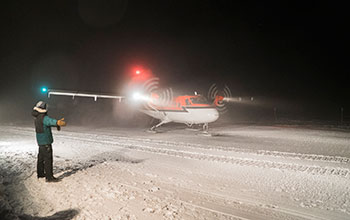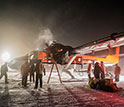News Release 16-077
Antarctic medical evacuation flight arrives at British Rothera Station
Twin Otter carrying two patients left South Pole early this morning

A Twin Otter aircraft on a medical evacuation flight taxis at NSF's South Pole station.
June 22, 2016
For b-roll, please contact Dena Headlee, (703) 292-7739 / dheadlee@nsf.gov
This material is available primarily for archival purposes. Telephone numbers or other contact information may be out of date; please see current contact information at media contacts.
The Twin Otter aircraft flying an Antarctic medical evacuation mission has arrived at the British Antarctic Survey's Rothera Station.
The plane, carrying two patients, arrived at Rothera at approximately 1:15 p.m. Eastern Daylight Time (EDT) this afternoon. The plane left the National Science Foundation (NSF) Amundsen-Scott South Pole Station in the early morning hours of June 22 EDT.
The aircraft arrived yesterday afternoon at the station, at which point the crew began a 10-hour rest period. Following crew rest, the team checked the weather at both the pole and Rothera and decided conditions warranted flying immediately north.
NSF determined that, to mitigate risks, the team would use the opportunity to evacuate a second patient. Both patients are seasonal employees through Lockheed Martin Antarctic Support Contract, the prime contract for operations and research support to NSF for the U.S. Antarctic Program.
Both patients now will be flown to a medical facility that provides a level of care not available at the South Pole. NSF is not discussing any details of the patients' medical conditions or providing any personal details.
For more background on the medical evacuation flight, please see this news release.
-NSF-
-
A Twin Otter aircraft on a medical evacuation flight on the ice at the South Pole
Credit and Larger Version
Media Contacts
Peter West, NSF, (703) 292-7530, email: pwest@nsf.gov
The U.S. National Science Foundation propels the nation forward by advancing fundamental research in all fields of science and engineering. NSF supports research and people by providing facilities, instruments and funding to support their ingenuity and sustain the U.S. as a global leader in research and innovation. With a fiscal year 2023 budget of $9.5 billion, NSF funds reach all 50 states through grants to nearly 2,000 colleges, universities and institutions. Each year, NSF receives more than 40,000 competitive proposals and makes about 11,000 new awards. Those awards include support for cooperative research with industry, Arctic and Antarctic research and operations, and U.S. participation in international scientific efforts.
Connect with us online
NSF website: nsf.gov
NSF News: nsf.gov/news
For News Media: nsf.gov/news/newsroom
Statistics: nsf.gov/statistics/
Awards database: nsf.gov/awardsearch/
Follow us on social
Twitter: twitter.com/NSF
Facebook: facebook.com/US.NSF
Instagram: instagram.com/nsfgov



